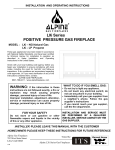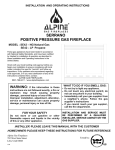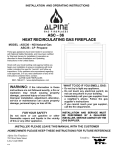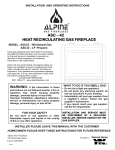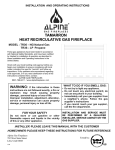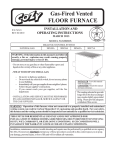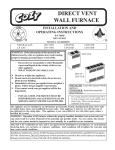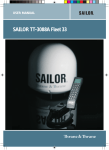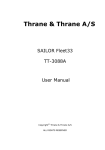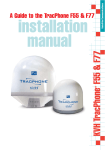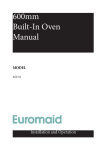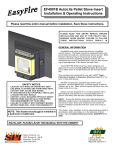Download Alpine STi - NG Operating instructions
Transcript
INSTALLATION AND OPERATING INSTRUCTIONS
STi Series
HEAT RECIRCULATING GAS FIREPLACE
MODEL : STi – NG Natural Gas
STi – LP Propane
These gas appliances have been tested in accordance
with National Safety Standards, and have been certified
by Warnock Hersey for installation & operation as
described in these Installation and Operating
Instructions in the United States.
Check with your local building code agency before you
begin your installation to ensure compliance with local
codes, including the need for “permits” and follow-up
inspections. If any problems are encountered regarding
code approvals, or if you need clarification of any of the
instructions contained here, contact:
ALPINE GAS FIREPLACES
#801-768-8411 / www.alpinefireplaces. com
WARNING:
If the information in these
instructions are not followed exactly, a fire or
explosion may result causing property
damage , personal injury or loss of life.
Improper installation, adjustment, alteration,
service or maintenance can cause property
damage, personal injury or loss of life.
FOR YOUR SAFETY
Do not store or use gasoline or other
flammable vapors and liquids in the vicinity
of this or any other appliance.
WHAT TO DO IF YOU SMELL GAS:
• Do not try to light any appliance.
• Do not touch any electrical switch; do
not use any phone in your building.
• Immediately call your gas supplier from
a neighbor’s phone. Follow the gas
supplier’s instructions
• If you cannot reach your gas supplier,
call the fire department.
INSTALLATION AND SERVICE MUST
BE PERFORMED BY A QUALIFIED
INSTALLER, SERVICE AGENCY OR THE
GAS SUPPLIER.
INSTALLER: PLEASE LEAVE THIS MANUAL WITH THE CUSTOMER
HOMEOWNER: PLEASE KEEP THESE INSTRUCTIONS FOR FUTURE REFERENCE
Alpine Gas Fireplaces
782 West State Street
Lehi, Utah 84043
7/00
Tested by:
IT S
TABLE OF CONTENTS
SAFETY INFORMATION
Safety Label...................................................3
Before Start....................................................4
General Safety Information ...........................4
System Specifications....................................5
SITE AND INSERT PREPARATION
Preparing Existing Fireplace .........................5
Preparing the Insert........................................6
Removing the Glass...........................6
Removing the
Appliance Adapter.............................6
Preparing the Leveling Bolts .............6
OPERATION & MAINTENANCE
Operating Instructions ................................12
Fireplace Maintenance................................13
Replacing the Glass ....................................14
Log Replacement........................................14
Normal Operating Sounds ..........................15
Clearance Information ................................16
Instruction Plate..........................................17
Troubleshooting Guide ...............................18
Replacement Parts List ...............................19
Exploded View ...........................................20
Warranty Information……………………..21
Routing Gas Piping To the Fireplace ............6
Chimney Liners .............................................7
Installing Chimney Liners .............................8
Positioning the Insert .....................................9
INSTALLATION
Electrical Connections...................................9
Complete the Gas Connection .......................10
Log Installation..............................................10
TESTING AND ADJUSTMENT
Primary Air Adjustment ................................10
Pilot Light Adjustment ..................................11
Derating the Burner .......................................11
TRIM
Trim Panel Installation ...............................11
Fastening Face Pieces.....................11
Control Panel Access
Door Installation .............................11
IMPORTANT:
SAVE THESE INSTRUCTIONS
The STi Series Direct Vent Fireplace must be installed
in accordance with these instructions. Carefully read all
the instructions in this manual first. Consult the
“authority having jurisdiction” to determine the need for
a permit prior to starting the installation. It is the
responsibility of the installer to ensure this fireplace is
installed in compliance with the manufacturer’s
instructions and all applicable codes.
This insert is intended to be installed by professional
installers that understand the principles of proper gas
installation techniques, venting principles, and safety
clearances. This manual is written with an assumption
that certain basic knowledge of this product exists with
the installer. The installation of this appliance should
not be attempted by anyone not familiar with these
basic principles.
Remote Control (Optional).........................11
2
Alpine STi Series Gas Fireplaces
Alpine STi Series Gas Fireplaces
Field Converted
Put Label Here
VENTING: Use Only Simpson Dura-Vent Termination Components. Use only Simpson vent cap #9080 on all
applications. This appliance must be installed in accordance with the manufacturer’s installation instructions and
with local codes, if any; if not, follow the current ANSI Z223.1 in the USA. Electrical supply 120VAC, .50 Amps,
60Hz. NOT FOR USE WITH SOLID FUEL. This vented gas fireplace is not to be used with air filters.
STi- 270 STi-310 STi-360
Orifice Size (DMS) 53
52
51
Minimum Input
21,000
24,000
26,000
Maximum Input
30,000
34,000
38,000
Altitude
2500-6500ft.
ASL
Minimum supply pressure
11”
WC
Manifold pressure high
10”
WC
Manifold pressure low
6”
WC
STi- 270 STi-310 STi-360
Orifice Size (DMS) 36
33
31
Minimum Input
18,000
21,000
22,000
Maximum Input
30,000
34,000
38,000
Altitude
2500-6500ft.
ASL
Minimum supply pressure
5”
WC
Manifold pressure high
3.5”
WC
Manifold pressure low
1.2”
WC
STi-360
PROPANE : Series STi-LP
Model: STi-270 STi-310
Alpine Gas Fireplaces
Lehi, Utah
NATURAL GAS : Series STi-NG
Model: STi-270 STi-310 STi-360
Listed: DIRECT VENT GAS FIREPLACE HEATER
Tested to: ANSI Z21.88 1998
Report No. 476-1808-00 (July 2000)
Serial Number: STi-
DO NOT REMOVE THIS LA-
Hearth Height
Hearth Depth
Mantel Clearance
Max. Mantel Depth
Min. Mantel Clearance
Mantel Depth
1/2”
Side Wall from glass frame
Ceiling from top of louver
E
F
C
D
C
D
A
B
0”
16”
18”
12”
13”
3
10”
48”
Clearances to Combustibles Unless Specified
SAFETY INFORMATION
3
INSTALLATION REQUIREMENTS
BEFORE YOU START
NOTE TO BUILDING CODE OFFICIALS: The
principles of installation outlined in this manual are
representative of the majority of installations that
are encountered. There are several variations to
these instructions that could be acceptable. If a
variance to these instructions is encountered, we
recommend that you contact the manufacturer
directly to verify these variations.
1) The appliance installation must conform with
local codes or, in the absence of local codes, with
the current National Fuel Gas Code, ANSI
Z223.1 installation code.
Safe installation and operation of this appliance
requires common sense, however, we are required by
ANSI Standards to make you aware of the following:
3) This appliance must be connected to the specified
vent and termination cap to the outside of the
building envelope. Never vent to another room or
inside a building. Make sure that the vent is fitted
as per venting instructions.
INSTALLATION AND REPAIR SHOULD BE
DONE BY A QUALIFIED SERVICE PERSON.
THE APPLIANCE SHOULD BE INSPECTED
BEFORE USE AND AT LEAST ANNUALLY BY A
PROFESSIONAL SERVICE PERSON. MORE
FREQUENT CLEANING MAY BE REQUIRED
DUE TO EXCESSIVE LINT FROM CARPETING,
BEDDING MATERIAL, ETC, IT IS IMPERATIVE
THAT CONTROL COMPARTMENTS, BURNERS
AND CIRCULATING AIR PASSAGEWAYS OF
THE APPLIANCE BE KEPT CLEAN.
4) Inspect the venting system annually for blockage
and any signs of deterioration.
DUE TO HIGH TEMPERATURES, THE
APPLIANCE SHOULD BE LOCATED OUT OF
TRAFFIC AND AWAY FROM FURNITURE AND
DRAPERIES.
9) Under no circumstances should this appliance be
modified. Parts that have been removed for
servicing should be replaced prior to operating
this appliance.
WARNING: FAILURE TO INSTALL THIS
APPLIANCE CORRECTLY WILL VOID YOUR
WARRANTY AND MAY CAUSE A SERIOUS
HOUSE FIRE.
10) Installation and any repairs to this appliance
should be done by a qualified service person. A
professional service person should be called to
inspect this appliance annually. Make it a practice
to have all of your gas appliances checked
annually.
CHILDREN AND ADULTS SHOULD BE
ALERTED TO THE HAZARDS OF HIGH
SURFACE TEMPERATURES, ESPECIALLY THE
FIREPLACE GLASS, AND SHOULD STAY
AWAY TO AVOID BURNS OR CLOTHING
IGNITION.
YOUNG CHILDREN SHOULD BE CAREFULLY
SUPERVISED WHEN THEY ARE IN THE SAME
ROOM AS THE APPLIANCE.
CLOTHING OR OTHER FLAMMABLE
MATERIAL SHOULD NOT BE PLACED ON OR
NEAR THE APPLIANCE.
4
GENERAL SAFETY INFORMATION
2) The appliance when installed, must be electrically
grounded in accordance with local codes, or in
the absence of local codes with the current
National Electrical Code, ANSI/NFPA 70.
5) Any safety glass removed for servicing must be
replaced prior to operating the appliance.
6) To prevent injury, do not allow anyone who is
unfamiliar with the operation to use the fireplace.
7) Wear gloves and safety glasses for protection
while doing required maintenance.
8) Be aware of electrical wiring in locations in walls
and ceilings when cutting holes for termination.
11) Under no circumstances should any solid fuels
(wood, paper, cardboard, coal etc.) be used in this
appliance.
12) The appliance area must be kept clear and free of
combustible materials, gasoline and other
flammable vapors and liquids.
13) If the pilot goes out for any reason, turn the
control knob to the off position. Wait five
minutes before attempting to re-light pilot.
14) Never obstruct the flow of ventilation and
combustion air to the fireplace. Always be sure
the vent termination and air inlets remain clear
and open.
Alpine STi Series Gas Fireplaces
INSTALLATION REQUIREMENTS
The appliance and its individual shutoff valve
must be disconnected from the gas supply
piping system during any pressure testing of
that system when test pressures are in excess
of 1/2 psig. The appliance must be isolated
from the gas supply piping system by closing
its individual manual shutoff valve during any
pressure testing of the gas supply piping
system when test pressures are equal to or less
than 1/2 psig.
SYSTEM SPECIFICATIONS
(2500 to 6500 feet altitude)
Burner Inlet Orifice Sizes:
NG
LP
#36
#33
#31
#53
#52
#51
Max. Input Rating –
STi – 270
STi – 310
STi – 360
30,000
34,000
38,000
30,000
34,000
38,000
Min. Input Rating –
STi – 270
STi – 310
STi – 360
18,000
21,000
22,000
21,000
24,000
26,000
STi – 270
STi – 310
STi – 360
Note: Output Capacity is a thermal efficiency rating
determined under continuous operating conditions and was
determined independently of any installed system. Vent
height may or may not change your efficiency ratings.
Min. Supply Pressure
Natural Gas
Propane
5.0” w.c.
11.0” w.c.
Max. Supply Pressure
Natural Gas
Propane
7.0” w.c.
13.0” w.c.
Manifold Pressure
Natural Gas
Propane
Because masonry chimneys may crack due to settling,
chimney fires, water damage, etc. A thorough
inspection for this type of damage is strongly
encouraged. Any substantial damage must be repaired
previous to installation. The flue liners provided
should be adequate if damage is minor.
PREPARING EXISTING FIREPLACE
FOR INSERT INSTALLATION
Thoroughly review the needed clearances on page
16 of this manual before proceeding.
1) When preparing an existing fireplace for an
Alpine insert, ensure that the clearances in this
manual are strictly adhered to.
2) Measure fireplace opening to ensure the
purchased product will fit.
3) Check fireplace dimensions on the installation site
before proceeding with installation. This will
ensure proper clearances and assist in identifying
potential problems before installation.
MINIMUM FIREPLACE OPENING
Model
STi-270
STi-310
STi-360
Width
27.5”
31.5”
36.5”
Height
20.5”
23 ”
25”
Depth
16.75”
16.75”
16.75”
4) Review the vent termination requirements before
proceeding with installation.
5) Ensure that the body of the appliance will fit into
the existing fireplace opening and that the existing
chimney can accommodate the two 3” liners
necessary for this insert.
6) To determine if the two chimney liners will fit
through the existing damper, the damper must be
either bolted or clamped open. If the liners will
not fit through the damper, or has excessive
bends, it must be removed.
7) Plan gas piping and routing (see “Routing Gas
Piping to Fireplace” on page 6).
3.5” +/-0.2” w.c.
10” +/-0.2” w.c.
Minimum Gas Line Pipe Size: 1/2”
Electrical 120 VAC System
Amperage Rating: 0.50 Amps
Variable Speed Fan: Variable Speed 160 CFM
Alpine STi Series Gas Fireplaces
5
INSTALLATION REQUIREMENTS
PREPARING THE INSERT
Slide Adapter to the Rear
Removing the Glass
The decorative glass trim must be removed before
insert installation.
1) To remove the glass, remove the two trim hooks
inside the valve chamber. (see figure 1)
2) Pull the bottom of the Trim forward about 4
inches.
3) Lift the trim up about ½ inch.
4) The trim should now be free and able to move
away from the appliance.
5) Take care to hold the glass in place, rapid
movements or rough handling will allow he glass
to fall out of the trim.
6) Set the trim aside so that it will not get damaged
during the installation process.
Remove Attaching Screw
Figure 2 - Removing the Appliance Adapter
Preparing the Leveling Bolts
Pull hook forw ard
and up to slot
on door bracket
The insert is equipped with two rear leveling bolts to
enable the fireplace to be easily leveled. These
leveling bolts need to be fully retracted prior to
inserting the appliance into the opening. This is done
to prevent damage to the existing fireplace hearth.
Once the appliance is located inside the fireplace
enclosure. The bolts may then be extended to level the
fireplace.
ROUTING GAS PIPING TO
FIREPLACE
Fig. 1– Removing the Trim Hooks
Note: Be sure not to damage the gasket on the glass.
Removing the Appliance Adapter
The appliance may have been shipped with the
Appliance Adapter installed. Gently remove the
adapter by sliding it to the rear of the appliance. (See
figure 2). Take great care not to damage the white
adapter gasket. If the Gasket is damaged, do not install
the appliance until the gasket is replaced.
The STi fireplace insert provides a gas piping inlet
hole on the front left side of the appliance. Gas piping
must be routed to this location prior to installing the
insert.
Determine where the fireplace will be positioned when
the installation is complete. Once this position is
determined, gas line positioning can also be
determined.
Note: Improper installation of gas piping is
potentially dangerous. All gas piping should be
installed by qualified individuals and strict
adherence to applicable codes is required. If you
are not familiar with gas piping or your local
codes, do not attempt to install the gas piping.
Note: Take special care not to damage the gasket
on the appliance adapter.
6
Alpine STi Series Gas Fireplaces
CHIMNEY LINERS
FLASHING
DAMPER
COMBUSTION AIR
VENT LINER
COMBUSTION AIR
Alpine STi Series Gas Fireplaces
7
VENTING REQUIREMENTS
INSTALLING CHIMNEY LINERS
Review page 7 to become familiar with the fireplace
as a system.
NOTE: Never connect this gas appliance to a
chimney or flue serving a separate solid-fuel
burning appliance.
The maximum vertical length of the venting system is
30’. The minimum vertical length of the venting
system is 8’. Horizontal termination of the vent is not
approved.
Two 3” chimney liners (#09400) are used with Alpine
STi series inserts. One liner will supply the
combustion air to the fireplace, the other will vent the
flue gases. Also required are:
• an appliance adapter which enables the liners to
be fastened to the insert (#29700)
• a co-linear adapter which enables the liners to be
joined with the termination cap (#09318)
• flashing to seal the flue tile
• a termination cap (#09317)
• two band clamps to fasten the liners to the
appliance adapter (#08530)
Installation Procedure
NOTE: Be sure to identify each liner in the
fireplace so you can make proper connections. If
the insert is vented improperly, it will not function
and may create a dangerous situation.
1) Measure the distance from the top of the flue tile
to the approximate top of the insert.
2) Add about 6” to your measurement and carefully
stretch each liner to that length.
3) Cut and bend the flashing to form a box type cap
to fit over the flue tile (the oval lip on the flashing
must be facing up).
T e r m in a t io n
C ap
C o - L in e a r
A d a p te r
Screw
C o m b u s t io n
A ir
E xh au st
V ent
Figure 3 -Connecting the Co-linear Adapter
8
Exhaust Vent
Intake Vent
Appliance Adaptor
Band Clamp
Figure 4 - Attaching Liners to Appliance Adaptor
4) Take the flashing and seal it to the flue tile with
some high quality sealant (remember the oval lip
on the flashing must be facing up to deter water).
5) Lower all but one foot of the vent liner through
the flashing into the flue tile.
6) Attach the liner to the co-linear adapter (see fig.
3).
7) Push the liner onto the nipple that flows through
the adapter until it seats against the gasket
material.
8) Fasten the liner to the adapter with 3-4 sheet metal
screws.
9) Lower the liner for combustion air and fasten it to
the co-linear adapter, in the same manner as the
vent liner, to the remaining nipple.
10) Lower the adapter onto the flashing and fasten
with sheet metal screws through the tabs provided.
Seal these screws with a high quality sealant to
prevent leaking. Seal around the adapter to
flashing joint.
11) Line up the lugs on the termination cap with the
receivers on the adapter and seat and then twist
the cap on.
12) Fasten the cap to the adapter with sheet metal
screws for added strength.
13) Slide the Exhaust Vent liner over the left outlet
on the appliance adapter. (See figure 4) Secure the
liner with one 3” band clamp.
14) Attach the Combustion Air liner to the remaining
nipple on the appliance adapter. Secure the liner
with one 3” band clamp.
15) Place the appliance adapter in its approximate
final position and, if needed, adjust the liners until
no severe bends or kinks exist. Be careful not to
tear or dent the liners or pull off one of the
connections. If a liner is punctured or torn, it must
be replaced.
Alpine STi Series Gas Fireplaces
VENTING REQUIREMENTS / INSERT PLACEMENT / ELECTRICAL
WARNING: Failure to position the parts in
accordance with these diagrams or failure to use
only parts specifically approved with this appliance
may result in property damage or personal injury.
ELECTRICAL CONNECTIONS
The simplest and most effective way to get power to
the system is to run a 120V A.C. line to the right side
of the fireplace. The 120V A.C. power runs through
the fan control switch, the thermostatic on/off switch,
and also the blower motor itself. These switches are
connected in series or end to end.
120 VAC
60HZ
(*by others)
Ground for
mobile home
Green (Ground)
Green
Note: Take special care not to damage the gasket
material on the appliance adapter. An improper
seal will inhibit proper operation of the fireplace
insert.
White (Neutral)
Black (Live)
Fan
Note: Be sure to protect the hearth with
cardboard, thin plywood, or light sheet metal to
prevent the inset from marring , or scratching the
hearth.
OFF
(*Supplied by others
install according to
local code)
White
Black
ON
(*by others)
Gently place the insert on the hearth and route the
blower wires to the back of the insert through the
blower adapter hole. Gently slide the insert into
position. Use the leveling bolts provided to adjust the
height and the level of the insert. Final leveling is not
required at this point. The adapter must be attached
to the appliance while it is being positioned. Make sure
the adapter is properly attached and secured before
proceeding. See Fig. 5.
White
POSITIONING THE INSERT
Black
(*by others)
Thermodisc
Figure 6 - Wiring Diagram
GROUNDING
NOTE: Star Washer must be placed between base
material and closed loop connector.
Note: The bottom trim panel will need to be
installed to adjust the height. See “Trim Panel
Installation”.
Exhaust Vent
Intake Vent
Band Clamp
Attach Fastening Screw
Slide Adapter in Gently
Figure 7 - Inserting the Fan
Figure 5- Connecting the Appliance Adapter
Alpine STi Series Gas Fireplaces
9
GAS REQUIREMENTS / LOG PLACEMENT / ADJUSTMENTS
NOTE: The appliance and its individual shut off
valve must be disconnected from the gas supply
piping system during any pressure testing of that
system in excess of 1/2 psig.
The appliance must be isolated from the gas
supply piping system by closing its individual
manual shut off valve during any pressure testing
of the gas supply piping system when test
pressures are equal to or less than 1/2 psig.
GAS CONNECTIONS
1) Install the final gas nipple into the fireplace insert
(the nipple should only extend about 3” past the
interior wall of the fireplace insert).
2) Connect the appliance gas shut off valve and
proceed to check for leaks (consult local building
officials for the accepted test procedure in your
area).
3) After testing the system for leaks, install the
connect the flexible appliance adapter to the gas
line.
4) Turn the gas supply on to the fireplace and test
again for gas leaks.
Fig. 8B - Log Installation
(310 & 360 Models)
UNIT TESTING AND ADJUSTMENTS
AERATION ADJUSTMENT
Pilot
Flame should
engulf the top
3/8" to 1/2"
Thermopile
LOG INSTALLATION
Gently remove the logs from their packaging.
Place the two largest logs on the locating pins on the
burner (the bigger of the two placed in the front and
the smaller placed to the rear). The face of the back
log should be even with the back of the burner,
centered, and then gently pushed down onto the
locating pin. The face of the front log should be
behind the front of the burner approximately 1/2 of an
inch and centered.
The number of top logs will vary depending
on the size of the insert (see fig. 8A & 8B). The 360
and 310 models have three top logs while the 270
model has two top logs. The top logs should be placed
on the cut out pads located on the top surface of the
two largest logs. They must be located in these
positions to avoid combustion related problems.
Note: A flame hitting directly on the bottom of a
log will burn dirty and cause excessive soot build
up on the log and inside the firebox.
Quick Drop out
Thermocouple
Fig. 9A– Pilot Flame Characteristics
Pilot Light Adjustment
The pilot light is preset at the factory and should
require no adjustment. The flame on the pilot should
project about 5/8” past the pilot head, with enough
flame to impinge on both the thermocouple on the left
side and the thermopile on the right side of the pilot
head. If the pilot is erratic, noisy, or yellow, call your
Alpine Fireplaces Dealer or another qualified service
technician to make the adjustment.
(Refer to figure 9A)
YELLOW TIPS
BLUE FLAME
BURNER BASE
Figure 8A - Log Installation (270 Model)
10
Figure 9B- Proper Flame Characteristics
Alpine STi Series Gas Fireplaces
ADJUSTMENTS / TRIM AND DOORS
PRIMARY AIR ADJUSTMENTS
The flame should have a blue base with yellow tips
(See fig. 9B). A dark orange flame with sooting and
black smoke indicates a lack of primary air. The
primary air shutter is located in the firebox on the right
hand side of the burner. Adjust the primary mixture by
loosening the set screw on the air shutter and
increasing the opening for more air and a bluer,
cleaner flame, or by closing the air shutter for a more
yellow flame. See figure 10.
The primary air adjustment is preset at the factory.
Little or no adjustment may be required for natural
gas. Propane will perform very differently at different
altitudes and from different fuel suppliers. Some
adjustment will most likely be needed for an appliance
burning propane.
5. Repeat step #4 on the left side.
6. With all pieces lined up and even, secure all screws.
7. See Figure 16 for an exploded view of the face
pieces and their proper locations .
8. With the screws tightened, test fit the glass panel to
make sure it will fit within the opening. Adjust the
panels if needed.
9. The top louver set may now be attached with four
bullet catches, two on each end.
10. The bottom louver set comes with the hinges
attached. Attach the hinges to the appliance and test
the louver set for proper function.
Venturi
Venturi Set Screw
Figure 10- Adjusting the Primary Air Mixer
DERATING THE BURNER
The fireplace has been designed to operate at
elevations approximately 4500 ft. above sea level. No
deration of the burner needs to occur unless the
fireplace is installed at elevations below 2500 ft. or
above 6500 ft. The burner orifice should then be
adjusted one drill size smaller for higher elevations
and one drill size larger for lower elevations.
TRIM AND DOOR INSTALLATION
Attach all trim panels before snugly tightening all of
the screws. This will provide you with the ability to
make all joints uniform.
1. Attach the bottom trim piece with the screws
provided.
2. Attach the top trim panel
3. Attach the left and right side panels
4. Line up the outside edge of the right side piece with
the edge of the top piece. Line up the right side piece
with the bottom piece. Secure the right side piece.
Figure 11– Face Trim Installation
Control Panel Access Door Installation
1) Place two hinges on the access door in the open
position.
2) Lay the door on the fireplace with the hinge
mounting holes positioned over the two mounting
holes located on each side of the fireplace.
3) Secure with the four #8 self-tapping screws
provided.
REMOTE CONTROL (OPTIONAL)
An Alpine Remote Control Kit (08501) may be
installed on this fireplace. The remote control kit
comes with a hand held transmitter, and a receiver.
The remote control is thermostatically controlled so
you can set the fireplace to the desired room
temperature, and have that temperature maintained.
The remote control is battery powered and will require
periodic maintenance to keep the system working
properly.
Alpine STi Series Gas Fireplaces
11
OPERATING INSTRUCTIONS
Millivolt Lead Table
The millivolt system has limitations on the distance it
can be installed from the fireplace. The greater the
distance from the fireplace, the larger the wire size
must be to prevent loss of the millivoltage. See the
table below for recommendations.
Maximum Length
Wire Guage
9’
22 ga.
13’
20 ga.
20’
18 ga.
30’
16 ga.
50’
14 ga.
To wall switch,
remote control
or thermostat
TH
HI
TP TH
TP
LO
Figure 12 – Gas Valve Connections
Thermocouple
in located
on back of
control
valve
on
IGNITOR
BUTTON
(PIEZO)
pi lot
off
LO
A
WALL
SWITCH
(M ILLIVOLT)
BURNER
ON/OFF
WHITE
BROWN
RED
RED
RED
"S.I.T."CONTROL
VALVE
REMOTE
ON
OFF
REMOTE
RECEIVER
(DC/
MILLIVOLT)
(OPTIONAL)
WALL
THERMOSTAT
(MILLIVOLT)
(O PTIONAL)
Fig. 13– Millivolt Schematic Wiring
1. Choose a convenient location on the wall to install
the receiver unit. A standard electrical box may be
used. Run wires from the fireplace valve to the desired
wall location. See the millivolt lead table below for
maximum wire runs.
2. Connect the wires to the gas valve (see figure 12 &
13).
3. Follow the installation instructions included with the
remote control kit.
OPERATION & MAINTENANCE
OPERATING GUIDELINES
1) Make sure the on/off switch is in the off position.
2) Make sure gas supply is on, and shut off valves
are open.
3) Push in gas control knob slightly and turn
12
7) Depress gas control knob completely and hold.
Push in red igniter button just to the left of the
valve until an audible click is heard. This creates
the spark to light the pilot. The igniter may need
to be pushed several times before the pilot lights.
Once the pilot is lit, continue to hold the control
knob in for 60 seconds. Release the knob and it
should pop back out to it’s original position. The
pilot should remain lit. If pilot goes out repeat
steps 3 through 7.
8) If the glass has been removed for initial start up of
Note: If the pilot will not stay lit after several
tries, turn the gas control knob to the “off” position and call your Alpine dealer, your gas supplier, or another qualified service technician.
WHITE
HI
E
Note: There may be air in the gas line that needs
to be purged out when first lighting the appliance.
To thermopile
PILOT
gas
inlet
clockwise to the “off” position.
4) Remove glass for initial startup.
5) Wait five minutes for any gas which may be
present in the combustion area to escape. If you
then smell gas stop the lighting procedure and
refer to the cover page of this manual for
instructions on what to do if you smell gas. If you
don’t smell gas then go to the next step.
6) Turn gas control knob counter clockwise to the
“pilot” position.
the appliance, it must be replaced before igniting
the main burner.
9) Turn the gas control knob counter clockwise to
Note: On cold start up of the fireplace the pilot
should be allowed to run for at least five minutes
to start a draw, and to allow the thermopile time
to heat up before turning the fireplace on.
the “on” position.
10) Place the “on/off” switch in the “on” position (the
fireplace should light immediately).
11) Flame height may be varied by the HI-LO knob
on the gas valve. Turning the knob counter
clockwise will increase the flame height and
turning it clockwise will decrease the flame
height.
12) The fan control switch will vary the speed of the
fan or turn the fan off. The fan is also turned on
and off by a thermally activated switch built into
the firebox. This will prevent the fan from
blowing cold air into the home. There are many
flame height and fan speed variations which may
be adjusted to meet an individual comfort level.
Alpine STi Series Gas Fireplaces
SERVICE INFORMATION
13) In the event of a power outage, your Alpine
fireplace my still be used as a source of radiant
heat. However, the fireplace is most effective and
efficient with the fan running.
14) To turn the fireplace off , simply pull down the
control panel access door and turn the on/off
switch to the off position. The fan will turn itself
off after the fireplace has sufficiently cooled
down. It is not necessary to turn the fan control
switch off.
15) For complete shut down of the appliance,
including the pilot, simply depress the control
knob on the gas valve, and rotate clockwise to the
“off” position.
5) The appliance and the venting system must be
inspected before use, and at least annually, by a
qualified field technician. The vent must be
inspected to ensure that the flow of combustion air
and ventilation air is not obstructed.
6) Do not use this appliance if any part has been under
water. Immediately call a qualified service
technician to inspect the appliance and to replace
any part of the control system and any gas control
which have been under water.
7) If the venting system is disassembled for any reason
it must be properly resealed as per the instructions
in the venting section of this manual. Never operate
the appliance if the venting system is not properly
sealed.
SERVICE INFORMATION
Fireplace Maintenance
1) Before performing any service on the appliance,
ensure the gas has been completely shut off, the unit
cooled, and the electricity shut off to the appliance.
2) The burner and valve control compartments must
be cleaned annually. A vacuum with a brush
attachment works well. The logs should be cleaned
gently with a soft bristle brush. The logs are fragile
and are easily damaged.
3) Clean the appliance with a damp cloth. Never use
abrasive cleaners. The glass should be cleaned with
a gas fireplace glass cleaner. The glass will slowly
build a thin white film on the inside. This film is
normal and can be removed using a fireplace glass
cleaner available at your local dealer.
CAUTION: DO NOT USE OVEN CLEANER TO
CLEAN THE GLASS
Note: It is also highly recommended to apply the
glass cleaner to the inside of the glass before the
first burn.
Note: Every time the appliance is started, while
cold, condensation will occur on the inside of the
glass panel. This condensation will clear as the
appliance heats up.
4) The fireplace is finished with a high temperature
paint. If your fireplace needs to be repainted or
touched up contact your local dealer for StoveBright
Paint.
Note: During the first hours of operation there
may be a slight odor omitted from the fireplace
due to the curing and burning of the paints, and
construction lubricants.
GOLD or NICKEL TRIMS
The gold plate or nickel trims on the fireplace require
little maintenance. If the pieces get fingerprints or dust
build-up, you should use a damp cloth only for
cleaning. DO NOT use cleaners of any type on the
gold or nickel. Be sure to clean any fingerprints off of
the unit BEFORE turning the fireplace on.
REMOVING VALVE
1) Open the bottom valve door
2) Shut off the gas supply
3) Disconnect the inlet gas line (3/4” wrench)
4) Disconnect the 2 TP wires from the valve
5) Disconnect the 2 TH wires from the valve
6) Disconnect the pilot tube from the valve (use a
7/16” wrench)
7) Disconnect the thermocouple from the valve (use
9mm wrench)
8) Disconnect the main burner tube (11/16” wrench)
9) Remove the 2 square nuts securing the valve holder
to the floor
Remove the valve from the appliance
INSTALLING VALVE
1) Mount valve to valve holder
2) Place valve / valve holder back into position
3) Secure valve with 2 square nuts
4) Connect main burner gas tube (use 11/16” wrench)
5) Connect the thermocouple to the valve (use a 9mm
wrench)
6) Connect the pilot tube to the valve (use 7/16”
wrench)
7) Connect the TH wires to the valve
8) Connect the TP wires to the valve
Alpine STi Series Gas Fireplaces
13
SERVICE INFORMATION
9) Connect the main gas supply to the valve (use a
3/4” wrench)
10) Double check to make sure all connection are
complete and tight
11) Restore gas supply
12) Using a soap solution, check for leaks in main gas
supply.
13) Make sure the toggle switch is in the “OFF”
Position
14) Ignite pilot and check for leaks in pilot line
15) Ignite main burner and check for leaks in main
burner tube.
3) Remove all loose or damaged glass from the frame.
4) Insert the new glass panel with the gasket preinstalled
5) Use the 6 existing Tinnerman glass clips to hold the
glass in place.
6) It is imperative that the glass be spaced in the frame
so that it is lightly resting within the door frame.
Glass with Gasket
Glass Clip
CAUTION: Never use an open flame to check for
gas leaks. Always use a soap solution to check for
leaks.
GLASS GASKET
If the glass gasket needs to be replaced, use a 3/8”
tadpole gasket. contact your local dealer for the correct
replacement part. Never attempt to use any gasket,
other than the correct replacement on the glass. Use
part # 07840.
GLASS PANEL
WARNING: Do not slam the door or strike the
ceramic panel with a heavy or hard object.
Breakage of the panel will result.
WARNING: Do not operate the appliance with the
glass front
removed, cracked, or broken.
Replacement of the glass panel should be done by a
qualified service technician.
Your fireplace is supplied with a pane of high
temperature 5mm neoceram glass panel that is capable
of withstanding the highest heat that your fireplace can
produce. Never attempt to use another type of glass or
other material. If your glass requires cleaning, you
should obtain an approved fireplace glass cleaner
available at your fireplace dealer. Do not use abrasive
cleaners to clean the glass panel. DO NOT CLEAN
THE GLASS WHEN IT IS HOT!
In the event that you break your glass by impact,
purchase your replacement from an authorized Alpine
dealer. See the replacement parts list for ordering
information. Follow the replacement steps below.
Replacing the Glass
1) Remove the door by releasing the glass clip springs
found in the valve chamber area.
2) Always where gloves to protect yourself from
sharp edges.
14
THERMOPILE / THERMOCOUPLE
1) Remove the glass door
2) Open the bottom valve chamber
3) Double check to make sure gas supply is turned off
4) Disconnect the thermocouple by loosening nut from the
valve with a 9mm wrench. Disconnect the thermopile by
loosening 2 screws marked TP on the valve.
5) Remove the two 1/4” screws holding the pilot assembly
in its bracket. Gently lift the pilot assembly up 2”.
6) Disconnect the thermopile and thermocouple with a
7/16” wrench.
7) Replace the thermocouple or thermopile.
8) Reinstall in reverse order.
LOG REPLACEMENT
The fireplace must never be operated if the logs are broken
or damaged. To replace the logs follow the steps below.
1) Turn off the gas supply and allow the fireplace to cool
completely before servicing.
2) Open the glass door panel.
3) Gently remove the logs from the firebox. Be sure to note
their position.
4) Obtain the proper replacement for the broken log.
5) Replace the log set and close the door panel.
NOTE: It is critical that the logs are placed in the
proper locations. Improper positioning of logs may
create carbon build-up and will severely alter the unit’s
performance. Poor appliance performance caused by
improper log installation is not covered under
warranty.
Alpine STi Series Gas Fireplaces
SERVICE INFORMATION
INSPECTING THE PILOT / BURNER
Periodic inspection of the pilot and main burner is
required. Figure 15, located on page 11 of this
manual, illustrates proper flame characteristics for the
main burner. See figure 19 below for proper pilot
flame characteristics.
NORMAL OPERATING SOUNDS OF
It is possible that you will hear sounds during the operation of your gas fireplace insert. These sounds are
perfectly normal and should not be considered defects
in your appliance.
Blower:
Alpine uses a State of the Art blower to push the
heated air throughout your home. It is not unusual for
the fan to make a rushing air sound when it is on. This
sound will increase and decrease in volume depending
on the speed of setting of your blower controller.
Metal Firebox:
The firebox is made of a high quality steel. Steel, by
its very nature, expands and contracts as it heats and
cools. You will often hear a “ticking” or “clicking”
sounds as the appliance heats and cools. Again, this is
normal for steel fireboxes.
Pilot Flame:
While the pilot flame is on it can make a slight hissing
sound. This is also normal
Gas Control Valve:
As the gas control turns ON and OFF, a click sound
may be audible. This is the normal operating sound of
a gas valve.
Alpine STi Series Gas Fireplaces
15
CLEARANCE REQUIREMENTS
CLEARANCE REQUIREMENTS
12 10 8
6
4
2
0
23
Clearances to Combustibles Unless Specified (Fig. 14)
18
Sides
Ceiling
A
B
10”
48”
16
Mantel Clearance
Mantle Depth
C
D
See Figure 15 & 16
See Figure 15 & 16
Hearth Height
Hearth Depth
Minimum Hearth Width
E
F
G
0”
16”
48”
12" mantel
8" mantel
14
3-1/2"
mantel
12
10
faceplate top
top of
fireplace
side view of
fireplace
Fig. 15 - Mantel Clearance
Fig. 14 - Insert Clearances
Fig. 16 - Hearth Clearances
16
Alpine STi Series Gas Fireplaces
OPERATING INSTRUCTIONS
FOR YOUR SAFETY READ BEFORE LIGHTING
This appliance must be installed in accordance with local codes, if any;
If not, follow the current ANSI Z223.1
WARNING: If you do not follow these instructions exactly, a fire or
explosion may result causing property damage, personal injury or loss of
life. Improper installation, adjustment, alteration, service or maintenance
can cause injury or property damage. Refer to the owner’s information
manual provided with this appliance. For assistance or additional
information consult a qualified installer, service agency or gas supplier.
A) This appliance has a pilot which must
be lighted by hand. When lighting the
pilot, follow these instructions exactly.
B) BEFORE LIGHTING smell all around
the appliance area for gas. Be sure to
smell next to the floor because some
gas is heavier than air and will settle
on the floor.
WHAT TO DO IF YOU SMELL GAS
−
−
−
−
Do not try to light any appliance
Do not touch any electrical switch, do
not use any phone in your building.
Immediately call your gas supplier from
a neighbors phone. Follow the gas
suppliers instructions.
If you cannot reach your gas supplier,
call the fire department.
C) Use only your hand to push in or
turn the gas control knob. Never use
tools. If the knob will not push in or
turn hand, don’t try to repair it, call
a qualified service technician. Force
or attempted repair may result in a
fire or explosion.
D) Do not use this appliance if any part
has been under water. Immediately
call a qualified service technician to
inspect the appliance and to replace
any part of the control system and
any gas control which has been
under water.
This appliance needs fresh air for safe
operation and must be installed so there are
provisions for adequate combustion and
ventilation air.
CAUTION: Hot while in operation. Do not touch. Keep children, clothing,
furniture, gasoline and other liquids having flammable vapors away. Keep
burner and control compartment clean. See installation and operating
instructions accompanying appliance.
LIGHTING INSTRUCTIONS
STOP! Read the safety information above on
this label.
1) Push in gas control knob slightly and turn
clockwise C to “OFF”. Knob cannot be
turned from “PILOT” to “OFF” unless
knob is pushed in slightly. Do not force.
2) Wait five (5) minutes to clear out any gas.
If you then smell gas STOP! Follow “B”
in the safety information above on this
label. If you don’t smell gas, go to the next
step.
3) Turn knob on the gas control
Pilot Burner
THERMOPILE
Clockwise to “OFF”
C
4) Push in control knob all the way and hold
in. Continually push and release the red
button on the spark ignitor until pilot
lights. Continue to hold the control knob
in for about 1/2 minute after the pilot is
lit. Release knob and it will pop back up.
Pilot should remain lit. If it goes out,
repeat steps 1 to 4. If knob does not pop
up when released, stop and immediately
call your service technician or gas
supplier. If the pilot will not stay lit after
several tries, turn the gas control knob to
“OFF” and call your service technician or
gas supplier.
5) Turn gas control knob counterclockwise
D to “ON”
6) Use the toggle switch to operate main
burner.
TO TURN OFF GAS APPLIANCE
1) Push in the gas control knob slightly and
turn clockwise
C to “OFF”. Do not force.
2) Turn off all electric power to the appliance
if service is to be performed.
DO NOT REMOVE THIS INSTRUCTION PLATE
Alpine STi Series Gas Fireplaces
DVI-700-1
17
SERVICE INFORMATION
NOTE: Before troubleshooting the gas control system, be sure the external gas shut off is in the “ON” position.
WARNING: TO PREVENT INJURY OR PROPERTY DAMAGE, REMOVE THE GLASS PANEL FROM
THE APPLIANCE BEFORE DOING ANY WORK ON THE GAS CONTROL SYSTEM. FAILURE TO DO SO
COULD RESULT IN GAS BUILD-UP AND EXPLOSION.
GAS SYSTEM TROUBLESHOOTING
PROBLEM
POTENTIAL
CAUSES
Spark igniter will
not light pilot.
Piezo wire loose
Defective Piezo ignitor
Piezo wire grounding out
Electrode is grounding out
Electrode is sparking at wrong
location
•
Check for spark at electrode and pilot. If no spark, disconnect
wire at electrode, put wire to ground, and try igniter again. If still
no spark follow the Piezo wire to Piezo igniter to see where
grounding may be occurring.
•
Position electrode into pilot so gas may be able to contact spark
Defective thermopile
Defective thermocouple
Thermopile / thermocouple
grounding out.
Loose thermopile leads
TP-THTP on valve
•
•
Check pilot flame, must impinge on thermopile and thermocouple
•
Be sure wire connections at gas valve terminals are tight and
thermopile and thermocouple are fully inserted into pilot bracket
•
•
Check switch wires to make sure they are not grounding
•
With the pilot ignited, turn valve knob to on. Take reading at TPTPTH with on/off switch in on position. Reading should be
100mv or greater. If reading is OK and pilot does not hold,
•
Check two way switch / wall switch for proper connections.
Jumper wire across terminals at wall switch. If burner comes on,
replace switch.
•
If okay, jumper wire at valve (TH-THTP). If unit turns on, replace
wires or check for loose connections
Pilot will not stay
lit after carefully
following lighting
instructions
CORRECTIVE ACTION
Defective automatic gas valve
Pilot burning, no gas
to burner.
Valve knob is on
Wall switch is on
Valve wire connections are
loose
Valve wires are defective
Frequent pilot
outage problems
Pilot flame may be too low or
blowing high causing the pilot
safety to drop out
Wall switch wires may be
grounding out.
Thermopile or thermocouple
may be grounding out.
Clean and/or adjust pilot so pilot is enveloped around thermopile
and thermocouple.
Check thermopile with millivolt meter. Take reading at
thermopile terminals of valve TP-TPTH. Should read 325
millivolts (circuit open) minimum while thermopile has pilot
flame on it.
• Clean and adjust pilot for maximum flame impingement on
thermopile and thermocouple.
• Trace wires from valve to wall switch for possible damage
or grounding against appliance or gas supply.
• Trace thermopile wires from valve to thermopile for
possible grounding against the appliance or gas valve.
• Follow same steps for thermocouple
Caution:
Any safety screen or guard removed for servicing an appliance must be replaced
prior to operating the appliance
18
Alpine STi Series Gas Fireplaces
REPLACEMENT PARTS INFORMATION
GAS PARTS
SIT Control Valve
04036
Flexible Gas Line Connector
04048
Burner Supply Line w/ Fittings 05114
Burner Orifice
STi 270NG 04054
STi 270LP 04099
STi 310NG 05112
STi 310LP 04102
STi 360NG 05113
STi 360LP 05111
Pilot Assembly
04038
Thermocouple
04040
Thermopile
04041
Propane Pilot Orifice
05082
Burner
STi 270
03200
STi 310
03201
STi 360
03202
Electrical Parts
Fan
KB Switch
Thermal Fan Switch
Piezo Ignitor Button
Thermostat (Wall Mount)
Wall Switch
Wire (Wall Switch/Thermostat)
08218
09232
08222
04046
08260
08255
08255
Face Trim, Logs, Fan Accessories
Glass - STi 270
06182
STi 310
06138
STi 360
06184
Glass Gasket
07840
Face Trim Frame (3 Pieces)
Brass Knob W/Screw
04032
Face Pieces
STi 270
Top 32130
Left 32135
Right 32140
B.F. 32145
Doors
STi 270
Valve 32065
Vent 32820
Logs
STi 270
STi 310
STi 360
Fasteners
Self Tapping Screws-#8
Self Tapping Screws-#10
Hardware Package
Door Hooks
Door Springs
Tinnerman Clips
Door Hinges
Bullet Catches
07631
07632
07632
08510
08515
08600
04081
04082
05149
06095
04079
Venting Components
Appliance Adaptor
29700
Gaskets
Pilot Assembly Gasket
Burner Supply Line Gasket
Thermal Fan Switch Gasket
Appliance Adapter Gasket
05100
05105
05101
29701
For current prices and policies covering
replacement parts, contact the factory or your
Alpine distributor or dealer. Parts will be
supplied at current prices. To order parts, you
must have the following information:
1.
2.
3.
4.
The model number of the appliance.
The part number.
A description of the part.
The purchase date of the appliance.
If you have any questions or problems, contact
your local distributor/dealer or:
STi 310
33130
33135
33140
33145
STi 360
34130
34135
34140
34145
STi 310
33065
33820
STi 360
34065
34820
Alpine STi Series Gas Fireplaces
Alpine Gas Fireplaces
782 West State Street
Lehi, Utah 84043
(801) 768-8411
19
EXPLODED VIEW
Termination Cap (#09317)
Venting Adapter (#09318)
Band Clamp (#08530)
3" Aluminum Venting (#09400)
Band Clamp (#08530)
Appliance Adapter (#29700)
Adapter Gasket (#29701)
20
Alpine STi Series Gas Fireplaces
WARRANTY
LIMITED LIFETIME WARRANTY
COVERAGE - This Limited Warrranty is issued by Alpine Gas Fireplaces, a division of Alpine Supply Company ("Alpine"), and extends only to the original
consumer purchaser. THIS WARRANTY GIVES YOU SPECIFIC LEGAL RIGHTS, AND YOU MAY ALSO HAVE OTHER RIGHTS WHICH VARY FROM STATE TO
STATE.
LIMITED ONE YEAR WARRANTY
The Alpine Gas Fireplace is warranted to be free of defects in materials and workmanship (does not include installation materials and installation labor) for
a period of one (1) year from the date of purchase when installed and used in accordance with the recommendations in the installation and operation instructions for the fireplace. The determination as to the existence of a defect and whether or not that defect is material shall be made in accordance with
accepted industry standards. Defective parts will be repaired or replaced at Alpine's option. Parts which are returned to Alpine and found defective on inspection will be repaired, or replaced with a new part, without charge to the purchaser as long as the part is still under warranty. All shipping charges will be
paid by the purchaser, and all new or repaired parts shipped to the purchaser shall be shipped freight collect (F.O.B. Lehi, Utah). Service calls ordered by
the customer, repairs, or parts which do not qualify for warranty shall be charged to the customer at then current rates for labor, parts and transportation.
LIMITED LIFETIME WARRANTY
In addition to the one year warranty described above, the firebox of the Alpine Gas Fireplace is warranted for life against through wall perforation when
installed and used in strict compliance with the recommendations in the installation and operation instructions for the fireplace, provided that the blower
has been installed and been kept operable and working whenever the fireplace has been in use, and there has been an approved and tested vent cap in
place on the chimney to prevent moisture from coming down the flue and causing the rusting of the firebox or other components. For purposes of this lifetime warranty, burnout means only the eroding of the interior metal floor, top, walls or heat exchanger in the top of the appliance, solely by fire action, to the
point that the erosion has resulted in one or more holes from inside of the firebox into the surrounding hot air chambers of the appliance. This lifetime warranty does not cover warping or rusting of the firebox. The damaged part or parts of the firebox will be repaired or replaced at Alpine's option. Parts which
are returned to Alpine and are found damaged by burnout on inspection will be repaired, or replaced with a new part, without charge to the purchaser as
long as the unit is still under warranty. All shipping charges shall be paid by the purchaser, and all new or repaired parts shipped to the customer shall be
shipped freight collect (F.O.B. Lehi, Utah). If the damaged part or parts under warranty cannot reasonably be removed and shipped to Alpine for replacement
or repair, Alpine will provide a serviceman to correct the defect at the location where the gas fireplace is installed without charge to the purchaser for labor
or materials, provided that the purchaser shall pay a reasonable charge for the transportation of the serviceman and needed parts and equipment from the
nearest Alpine service center to the location of the appliance and return.
LIMITATIONS - These one year and limited lifetime warranties are in lieu of all other express warranties. ALL IMPLIED WARRANTIES, INCLUDING ANY IMPLIED WARRANTIES OF MERCHANTABILITY OR OF FITNESS FOR ANY PARTICULAR PURPOSE, ARE SPECIFICALLY LIMITED TO A TERM OF ONE (1)
YEAR FROM THE DATE OF PURCHASE (SOME STATES DO NOT ALLOW LIMITATIONS ON HOW LONG AN IMPLIED WARRANTY LASTS, SO THE ABOVE
LIMITATION MAY NOT APPLY TO YOU). Alpine neither assumes nor authorizes any other person to assume for it, any additional liability in connection with
the sale, installation, replacement, or repair of the appliance.
EXCLUSIONS Alpine shall be held free and harmless from liability damage to property or injury to persons related to the installation or operation, proper or
improper, of the appliance. THESE ONE YEAR AND LIMITED LIFETIME WARRANTIES DO NOT COVER, NOR DOES ALPINE ASSUME, RESPONSIBILITY
FOR INCIDENTAL, SECONDARY, OR CONSEQUENTIAL DAMAGES. ( SOME STATES DO NOT ALLOW THE EXCLUSION OR LIMITATION OF INCIDENTAL OR
CONSEQUENTIAL DAMAGES, SO THE ABOVE LIMITATION OR EXCLUSION MAY NOT APPLY TO YOU.)
These one year and limited lifetime warranties do not cover:
1. Damage or malfunction resulting from accident, negligence, abuse, alteration, unauthorized service, damage during transportation, shipping or damage
caused by external fire, floods, acts of God, or any other casualty.
2. Damage or malfunction resulting from failure to follow the installation or operating instructions provided with the fireplace unit.
3. Damages or defects in any parts, equipment, accessories, materials, or items not manufactured, sold, or supplied by Alpine, or any damage resulting
from the use of such items, which are used on or in connection with the fireplace unit.
4. Damage to or defects in any glass windows or internal or external finishes, or any damage resulting there from, except as an examination by the purchaser may reveal at the time of delivery of the appliance and is reported immediately to Alpine.
5. Any expansion and contraction noises commonly found in heating equipment.
6. Damage or malfunction caused by trees or bushes located in the proximity of the vent or vent termination.
PROCEDURE TO OBTAIN PERFORMANCE UNDER WARRANTY It is recommended that you first contact your local dealer as the dealer may be able to
assist you with warranty or other service work. In any case, the following procedure must be followed for any and all warranty work;
If damage occurs or a defect is discovered which you believe is covered by this limited warranty, you must promptly notify Alpine of the damage or defect in
writing and provide reasonably satisfactory proof of the date of purchase of the appliance. All claims made by you under this warranty should be directed to
Alpine at the address below. The written notice must contain the name, address and phone number of the customer, as well as the name of the dealer, the
serial number of the appliance and the date purchased. Failure to give timely notice to Alpine of any material damage or defect will result in that damage or
defect being excluded from coverage.
Upon receipt Alpine will, within 60 days, repair, replace or service the parts or unit as covered by this Limited Warranty. Exceptions to this may be delays
that are caused by acts of God, labor problems or material shortages.
ALPINE GAS FIREPLACES
782 West State Street
Lehi, Utah 84043
(801)768-8411
www.alpinegasfireplaces.com
Alpine STi Series Gas Fireplaces
21





















